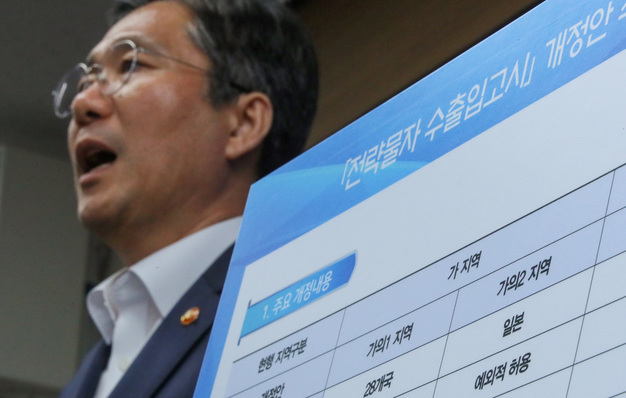Posted on : Aug.13,2019 17:04 KST
Modified on : Aug.13,2019 17:20 KST
 |
|
South Korean Minister of Trade, Industry, and Energy Sung Yun-mo announces the latest revisions to South Korea’s export controls on strategic materials at the Central Government Complex Sejong on Aug. 12. (Yonhap News)
|
The South Korean government announced measures on Aug. 12 that will strengthen controls on Japanese exports. The new policy appears to be a counter to the undue retaliatory trade measures imposed by Japan. After the Japanese government strengthened controls on Korean exports in response to the South Korean Supreme Court’s ruling on compensation for victims of forced labor, the latest development appears to be an inevitable move in a situation where the Japanese government has not changed its attitude and rejected an offer for negotiations by the Korean government.
Nevertheless, as economic conflict between the two countries is not desirable, efforts to attempt to resolve the dispute through dialogue and negotiations must continue to the fullest extent. The South Korean government should also continue to monitor any side effects that the new measures may have on domestic exporters.
The revision to the ‘rules on the export and import of strategic goods’ released by the Ministry of Trade, Industry, and Energy (MOTIE) on Aug. 12 reclassified Japan from “Region A,” a list of countries that receive preferential treatment through simplified export screening, to a newly created category called “Region A2.” Under the previous rules, all 29 signatories to the four major export controls systems on strategic goods, including the Wassenaar Arrangement, that were classified as Region A benefited from simplified export screening, while other countries were classified as “Region B.” However, under the revised rules, Region A has been divided into A1 and A2, the latter referring to countries that do not run their systems in line with the principles of the four major systems, despite being signatories to such agreements. Japan is the only country that has been placed in this category. Exports from A2 need to receive comprehensive or separate authorization every three years in principle, which represents a tightening of regulations that effectively relegates them to a level on par with Region B.
As for the reason behind the changes, the Ministry stated “The amendment was made because it is difficult to remain in close collaboration with countries that run their systems in a manner inconsistent with the principles of the international export control system.” Although the Ministry claims that the changes are not in response to the retaliatory measures adopted by Japan, it is difficult to deny that they appear to be retaliatory in nature due to the timing and content. The new rules seem to have been written based on a determination that most Japanese-made materials and components in Korea can be replaced with products made locally or procured from other countries, and the fact that there is growing concern within Japan about the repercussions of the Japanese government’s export regulations.
Depending on how Japan reacts to the latest measure, there is a high likelihood that the trade dispute between Korea and Japan will intensify. The new rules will come into effect starting next month after a 20-day period of canvassing public opinion, regulatory screening, and screening by the Ministry of Government Legislation. The South Korean government announced, “If the Japanese government seeks to engage in negotiations during the period of receiving opinions, we are prepared to accept at any time and place.” It is hoped that the Japanese government will agree to engage in proactive discussions this time and facilitate an opportunity for resolving the trade dispute through dialogue and negotiation.
Please direct comments or questions to [english@hani.co.kr]






